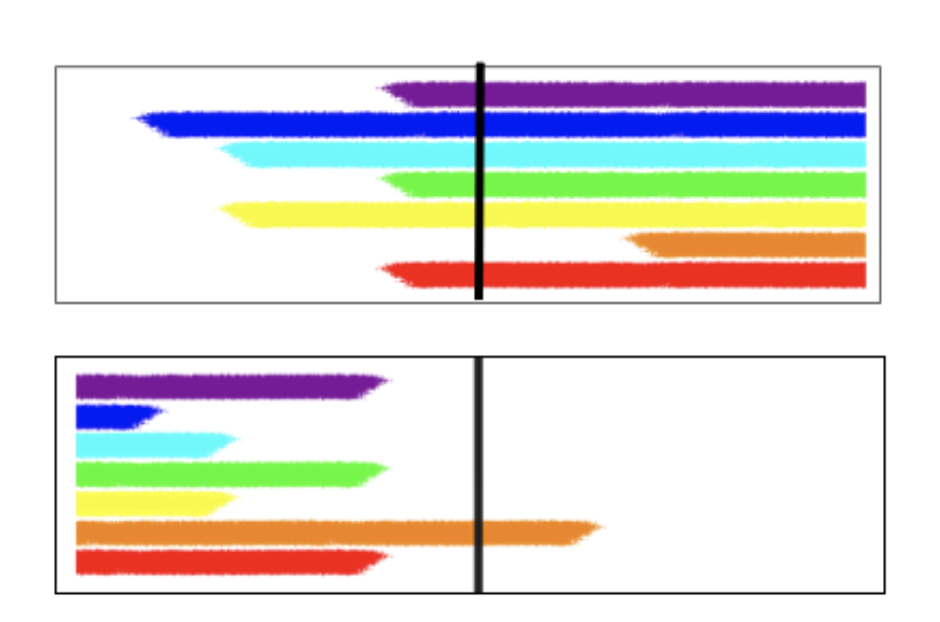When we discuss color-ray theory and Gemstone Color-Ray Therapy, we talk about certain types of color rays. You may have heard terms like “main ray,” “primary ray,” and “limiting ray.” But what exactly are these rays, and how are they different?
To be able to answer these questions, you first have to understand how we view the spectrums that contain these rays.
If you have heard of these terms before, I invite you to let go of all your previously learned ideas and walk with me through this explanation with new eyes. It has taken me years to figure this out, and I’m confident that now it all makes sense.
Below is an example of a color-ray spectrum called a resident spectrum. You’ll find ones like it throughout the body, from the smallest atom to the largest bone in our body, from the sweetest emotion to the most daring thought. Life abounds in spectrums.

We can measure the resident spectrum of any organ, tissue, or system of the body. These spectrums can also be tested for a chosen issue or condition, because each is a medley of feelings, memories, and thoughts, which are also comprised of spectrums.
You’ll notice that the above spectrum has varying amounts of color, red being the most deficient. In the spectrum below, indigo is the most deficient. We call the ray present in least amount the primary ray.

What Is a Primary Ray?
The primary ray is one of the most important color rays in a spectrum. It’s the ray that attracts things we need, such as nutrients, oxygen, positive feelings, healing applications, and anything else life requires.
Here’s why the primary ray attracts: The more deficient an area of the body is in a certain color ray, the more desperately it needs that color to replenish itself. The greater its need, the stronger its ability to call in another spectrum to fill that need. Since color rays exist only in spectrums, the primary ray will call in colors arranged into spectrums. These spectrums represent experiences.
The graphic below shows a resident spectrum on the left, with a red primary ray. It is calling in an experience spectrum (right) that is rich in all colors but primarily red ray. This experience spectrum would be curative, because it fills the entire designated area of the spectrum.

Most of our experiences do not fill the spectrum, as illustrated by the graphic below. We need many experiences to learn our lessons, cure our illnesses, and keep our bodies going.
The graphic below shows what a typical experience is like. It nourishes a little, but doesn’t do much to fill the spectrum. Though not curative, it does represent a small but significant step on a person’s healing journey.

Let’s now look at a specific example.
Healthy bones have a primary ray of indigo within a spectrum that is well nourished. A well-nourished spectrum has colors that fall to the right of the halfway mark (designated by the black vertical line).
Weakened bones may also have indigo as a primary ray, but the amount of the color in their resident spectrum (see graphic below) falls generally to the left of the halfway mark and is considered relatively deficient.
Bones with such a spectrum would call in experiences that are abundant in indigo. Such experiences would likely involve structure, intuition, dreams, or inner strength, all of which are usually associated with abundant indigo. These experiences help fill the indigo deficiency, and the bones receive the essential nourishment they need to heal.
In this example, however, with the indigo ray significantly deficient, the experience called in may very likely involve an injury. Even a stubbed toe calls in a great deal of our attention! With it comes healing energy to nourish the spectrum, so that next time we stub our toe, it won’t be as bad.

What Is a Limiting Ray?
A limiting ray is the color ray present in greatest abundance in a resident spectrum. However, not all spectrums have limiting rays. Having one color present in an amount far greater than the other colors is not a good thing because it prevents a spectrum with any significant amount of that color from being called in.
In the spectrum pictured below, the limiting ray is orange. Because there is already so much orange, there simply isn’t room for an experience with much orange in it. This is why we call it a limiting ray: it limits the types of experiences a person can call to himself.

What Are Secondary Rays?
Secondary rays define the type, nature, and character of the experiences that the primary ray calls in. Secondary rays are neither most deficient nor excessive and comprise the bulk of the spectrum.
In the graphic below, red, yellow, green, blue, and purple are considered secondary rays, even though they vary in their respective amounts.

Learn More About Color Rays
Our Color-Ray Healing Program includes home-study courses that teach you how to test, evaluate, and balance the spectrums that influence our health and well-being. You’ll learn everything you need to know to use Gemstone Color–Ray Therapy for yourself, your loved ones, or your clients.
